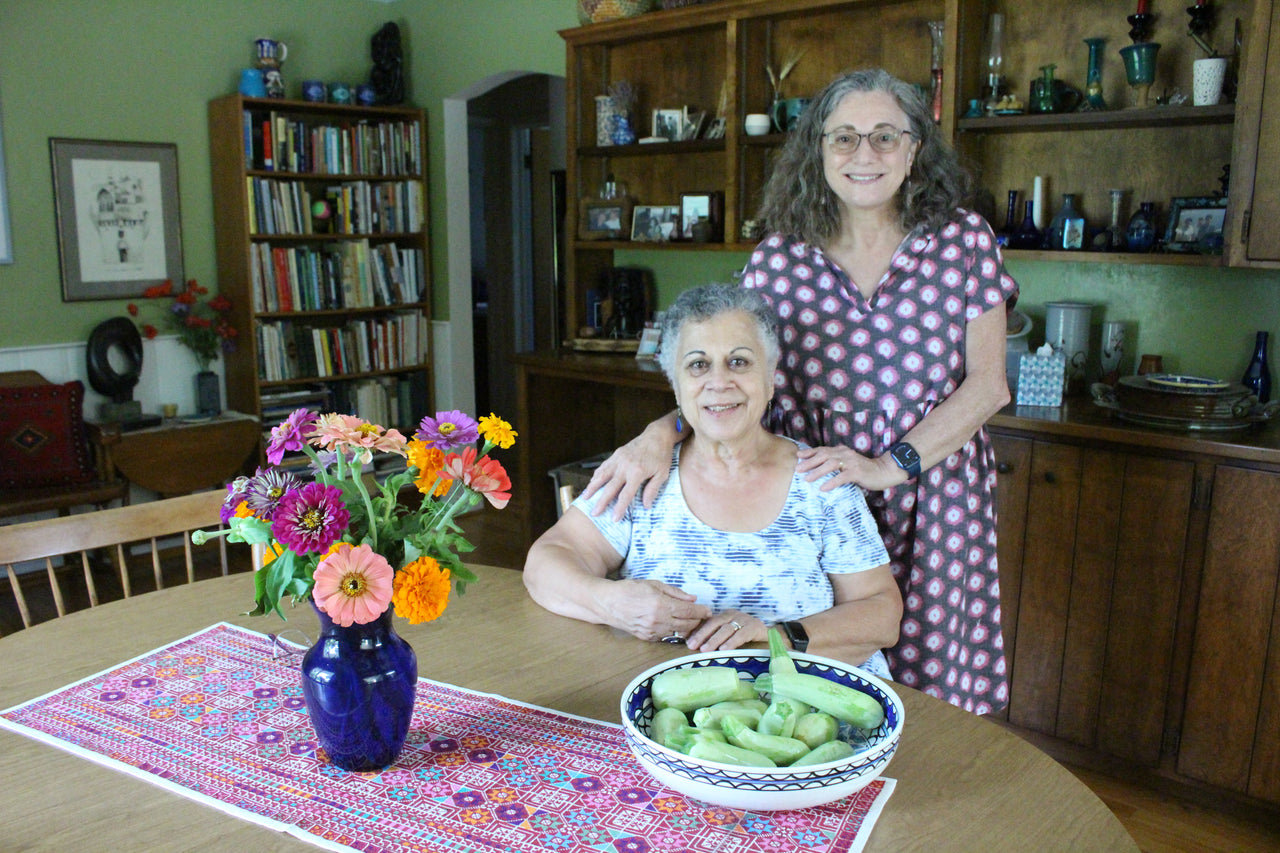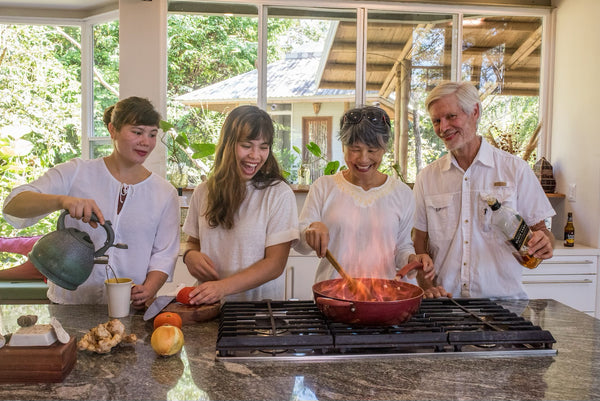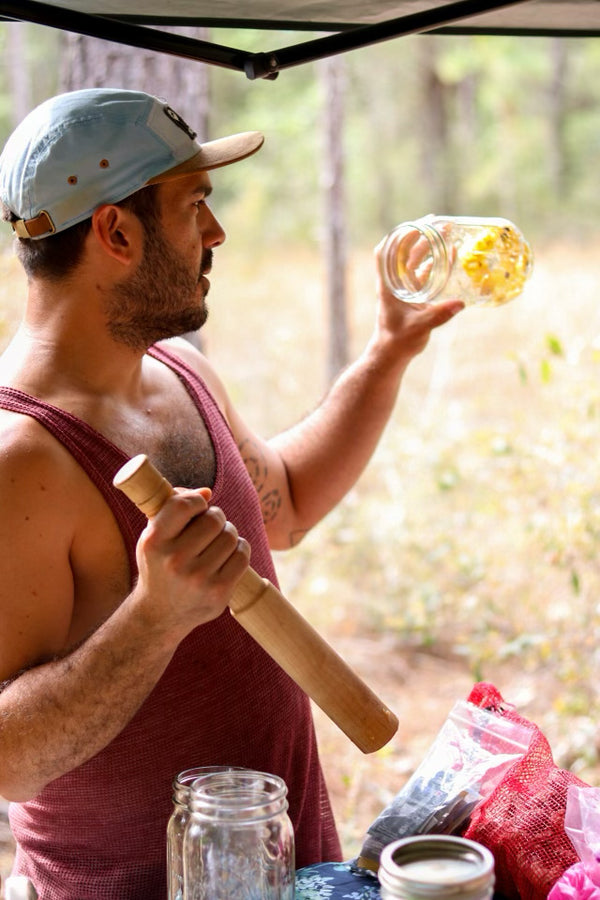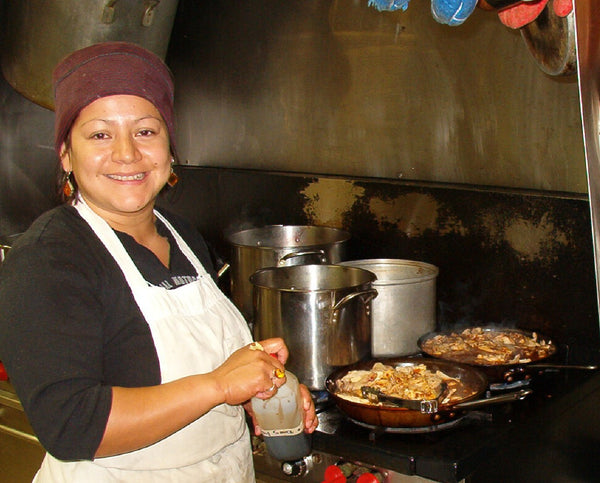This month, I interviewed Grace Stevick and Huda Karo, friends of the farm and longtime honorary sisters. We talked about kousa squash, a staple of Palestinian cuisine that speaks of home to both of them. Both were born in Haifa, a city in northeastern Palestine (current-day Israel) on the coast of the Mediterranean Sea. The interview took place at Huda’s home, in her beautiful sunroom filled with plants, art, and a gorgeous and welcoming array of furniture – a perfect environment for chatting the morning away. Even though I arrived a few minutes early, there were already plates and bowls full of treats displayed at the coffee table around which we’d be sitting; nuts and dried fruit, chocolates, and other assorted candies I didn’t recognize but that looked delicious. As Huda welcomed me into her home, she told me Grace would be there soon; “she always runs a bit late,” she said with sisterly fondness. The two obviously knew each other very well, and I looked forward to learning more about how they had met and become friends, about their stories, and perhaps, about whether they had any friendly disagreements over how to cook the best kousa squash.
From Haifa to Ann Arbor
When Grace arrived (10 to 15 minutes late, as Huda predicted), Huda brewed us some Turkish coffee to our liking, and we all sat down in the sunroom, where the morning sunlight filtered through the screened windows and began warming up the day. The two of them chatted away as old friends do, while I prepared my questions and set up my recorder. Their countenances were so warm, bright, and welcoming that I found myself simply wanting to enjoy their presence and hear whatever they had to say, no matter if it was kousa-related or not.
Grace and Huda were both born in the city of Haifa in Palestine, which is now within the borders of Israel on the northeast coast of the Mediterranean Sea. Due to conflict in that area, as Palestinians, both of their families fled when Zionist forces entered Haifa in 1948. They went to Lebanon seeking refuge from the unrest occurring in their homeland. Huda was able to return 7 months later to be counted in the 1949 census, but Grace stayed in Lebanon for much of her childhood. “Grace has this trauma of having home in her heart, but not in her reality,” Huda says sympathetically. “It’s in her DNA, in her family, who was well-known in Haifa.” This “home in the heart” theme is a common thread amongst immigrants, who have been forced to flee their homeland for a variety of reasons, but who continue to practice traditions and cook food that brings back memories of home in their new context, wherever that may be.
Eventually, employment at the University of Michigan brought Huda and Grace to the same city, and they met each other through their involvement at the Palestine Aid Society. They became fast friends, and are now as close as sisters.
Better than Zucchini
Sharing food together has only strengthened Grace and Huda’s bond over the years. One such meal that they claim as a staple for all Palestinians is stuffed kousa. Kousa is a type of summer squash, similar to zucchini, but which holds together well when cored in preparation for stuffing. It is a pearly, light green color, patterned with faint white dots as zucchini often is. The core and the skin are both tender and sweet, and tasting one for the first time I wondered why we use zucchini instead of kousa in the States. Grace tells me, “I don’t know any American who has tried kousa who hasn’t fallen in love with it,” and I believe her.
Kousa is incredibly versatile, and through my conversation with Huda and Grace I learned that, at least in Palestine, how they are cooked depends on the size that they are when harvested. “In Dearborn, Michigan there is a market that sells kousa in cases all organized by size,” says Grace. She proceeds to explain what each size increment of kousa should be used for. She tells me that the smallest kousa (3-5 inches long or so) are used for stuffing with meat in a dish called Ablama (pronounced ah-blum-ah). First, they core the kousa, which requires true skill “You wouldn’t be allowed to core the kousa until you were of a certain age,” says Huda. “They would use that as one of the measures of if you were ready to be married. How well you brew the coffee, cut up the watermelon, wrap your grape leaves – your readiness for marriage was determined by all those things,” she laughs. Once the kousa has been cored, the inside is stuffed with meat, either lamb or beef, depending on which Palestinian family/individual you talk to. The kousa is never cooked in a small pot, Huda and Grace both emphasize, and I suggest that it seems like a sort of “go big or go home” mentality. They both nod, chuckling.

Pictured: an assortment of the different tools used to core kousa.
The next size up is used for stuffing with meat and rice. “This is more about economy than anything else,” Grace says. Because they’re bigger, you can fit more in them, and to have them stuffed to the brim with only meat would be costly and wouldn’t be a very balanced meal. To prepare this dish, Grace will first cook the meat, spices, onions, and pine nuts separately. Then, she’ll stuff this into the cored kousa, along with rice. Finally, she fries them until they’re nicely browned and tender.

Pictured: stuffed kousa prepared by Grace Stevick.
Grace adds that for the largest size kousa (equivalent to many “normal size” zucchini we see in grocery stores in the States), you can stirfry it, grate and steam it and cook it with yogurt and garlic and fresh mint, or stuff it with eggplant, meat, and eggs, “like the Greeks do.”

Pictured: Meat and rice filling for the kousa.
No part of the kousa is wasted. Even the cored insides are taken and can be mixed with eggs and spices and fried into delicious patties. “I’ll serve them with yogurt, garlic, and cucumber,” says Grace. The softest, smallest kousa are also used as a food for babies once they’re starting to eat real foods. The squash is cut up, mushed, and served with yogurt. “I recently sent my niece who has an 8-month-old baby some kousa to cook for her baby to use as finger food. She loves it! It’s an easier soft food to eat,” Grace tells me.
I was starting to see that kousa was a lot more than just food to Grace and Huda. It was a way to strengthen community, remind them of home, and to share a part of themselves and their ancestry with new friends and family, of any age or background.
Vegetables on Steroids
When Huda and Grace first came to the States, there was no kousa. They made do with zucchini for a while, because it was the closest thing to kousa, but it fell apart more easily when being cored. “The veggies at US grocery stores [looked like they] were all on steroids! There were these huge zucchinis and gigantic, waxy cucumbers – what are those good for?” Grace asks rhetorically, the answer obvious to her. According to Grace, Palestinians generally preferred cooking with smaller veggies which have a more delicate taste and texture. It was a bit of a culture shock for them to see such enormous produce. But they adapted to what their new home had to offer.

Pictured: Homs Kousa squash.
Today, Grace and Huda are grateful to be able to access and celebrate their traditional kousa squash which can be found seasonally in Dearborn and at Middle Eastern markets, or can be grown from seed that is much more easily obtained than it was in the late 1900s and early 2000s (see our Homs Kousa Seeds here). Grace has a garden at a community plot through Project Grow in Ann Arbor, and is able to grow her own kousa. Huda has a grape vine and uses the leaves for stuffed grape leaves. Times have changed, and access to produce, land and seeds has made what was once impossible into something much more available. Now, Grace and Huda can have part of home both in their heart and in their reality.
Co-Creating Community
I could tell from our conversation that stuffed kousa was something Grace and Huda are proud of, and are eager to share. “It’s impossible not to fall in love with it!” they both claim. They love introducing the cherished summer squash to new friends and family.

Pictured: stuffed kousa squash and stuffed grape leaves, ready to be cooked!
Last summer, they invited Erica Kempter (co-owner of Nature & Nurture farm) to learn about Palestinian cuisine amongst a larger group of Palestinian women friends. Before Covid, these friends gathered regularly to cook, eat and celebrate together but had not met in a long time. Old friends were able to catch up, give each other hugs, and make a delicious meal to share together while doing it. Erica was welcomed into the warm group of friends and carefully shown how to stuff grape leaves. While preparing Palestinian cuisine, the women bantered about their own family’s recipes - who stuffed kousa with lamb vs. beef, how to choose the perfect grape leaf for stuffing, or which were the “right” spices to use in a certain dish. Erica learned that every family, every person, prepares their dishes differently. Yet, instead of being about who is “right” or “authentic,” an event like this is really about creating and strengthening bonds over sharing food together.
As I wrapped up our conversation about kousa, grape leaves, and community, the heat from the sun reached its peak and lit up the smiling faces of my new friends. The ability of food to create new connections, new friendships, and new community, is incredibly powerful, yet also gentle and subtle. Don’t underestimate it, folks.




